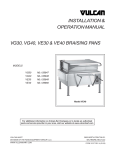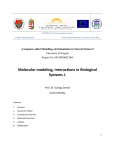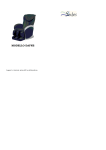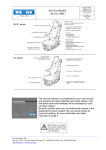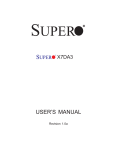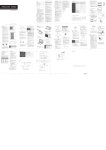Download Suunto X6 watch.
Transcript
Suunto X6 watch. Outdoors-Magazine.com http://outdoors-magazine.com Suunto X6 watch. James - Very old articles - Publication: Friday 8 November 2002 Update: 17 October 2002 Description : A test of the Suunto x6 wrist computer. Copyright (c) Outdoors-Magazine.com under a Creative Commons Attribution-Non-Commercial-Share Alike License Copyright © Outdoors-Magazine.com Page 1/11 Suunto X6 watch. This information is SERIOUSLY outdated. Suunto is a Finnish brand specialized in sports instruments, from diving computers, to compass and altimeters. The X6 is a: 1. 2. 3. 4. 5. 6. 7. Compass Barometer Altimeter Thermometer Clinometer Chronometer Two time-zones watch. I paid mine 280 Euros [1], classic street price is around 340 Euros. The Suunto X6 I have owned the Vector from the same maker and can attest of it's resistance, it is the only watch I have kept for four years, a resistance that the two Casio triple sensor I have owned never reached [2]. The vector had some defaults, it was big and thick, it had a plastic glass, and was water-resistant to only 30 meters. Copyright © Outdoors-Magazine.com Page 2/11 Suunto X6 watch. Compared to old Casio models and to the vector from left to right, top to bottom • • • • • • The first Casio with a barometer / altimeter / depth meter ever made. a Double sensor model (alit, thermo) another double sensor model a triples sensor model (alit, baron, compass, thermo) a Suunto Vector a Suunto X6 Thickness compared to the Suunto Vector (left) Copyright © Outdoors-Magazine.com Page 3/11 Suunto X6 watch. First contact The X6 has a mineral glass, is water-proof to 100 meters, and is of a reasonable size. Out of the box, you need to set it up, this is a pleasure, I could do it without the documentation through the menus of the watch. This interface is highly intuitive, like on Nokia mobile phones, a real pleasure on a complex watch. Menus of the X6 Copyright © Outdoors-Magazine.com Page 4/11 Suunto X6 watch. More details The watch includes a chronometer, 3 time alarms, and one repeat count-down timer. There is a way to have silent or noisy button pressing, a way to lock all buttons, an electro-luminescent background, which I sometimes use to see in total darkness, and which can be setup to light each time a button is pressed for night use, or on a special button. There is the choice of units (Hpa, mb, m, ft, 24 or 12 hours, american or european date format [3]. The compass Copyright © Outdoors-Magazine.com Page 5/11 Suunto X6 watch. One thing I found painful with digital compass is generally the calibration process. A digital compass need to be calibrated often, and if the calibration procedure is too difficult, this is a problem. The calibration procedure is the easiest and most accessible I have ever done. The precision of the compass is 1 degree, and the clinometer is used to tell if you are measuring while the watch is kept flat [4]. But There is no indicator to tell how flat you hold the watch, as the system used is to highlight the bearing (making it bold when the clinometer tells the watch it is in an acceptably flat position. So, while the precision of the compass is one degree when the watch is held flat, the real precision may be much less than that, as the clinometer accepts some 10 degrees variation. The precision is quite good when looking for the north or south, as in that case the watch does not need to be flat, but when measuring to west or east, the difference of measures on the compass is around 15 degrees in bearing. The bubble level of the Vector allowed for a much better precision. I do not understand, the calibration software emulated a bubble level, using the clinometer, so why did't Suunto included it to the measurement mode, is a mystery. I did a few tests in real, and with a precision compass trying to acquire targets and measure their bearings, I would say that the precision is finally good, generally in a 0 to 3 degrees range from the compass. I have some more tests to perform on this, and will update this article. The altimeter Copyright © Outdoors-Magazine.com Page 6/11 Suunto X6 watch. The altimeter has a one meter precision. all concurrents so far only deal in 5 meters increments. Altitude and climbing rate alarms are available. A "Log" can be taken of the altimetric data, giving marked points, highest, and lowest points, total ascent, total descent, etc... The barometer Copyright © Outdoors-Magazine.com Page 7/11 Suunto X6 watch. The barometer can provide a graphic of the last hours variations, and a "tempest alarm" that rings when pressure drops more than 4 Hpa in the last 3 hours. A log of the last 48 hours is constantly taken. The thermometer as always gives the temperature of the watch, which is not the air temperature or your temperature, but in-between, and needs a quarter of an hour to stabilize to air temperature, when removed from your wrest. The priority is given to the barometer or to the altimeter, though setup. So, in altimeter mode, any difference of pressure is interpreted as altitude, and while in barometer mode, as weather data. All other maker models, and the Vector model, did both at the same time, and ultimately, if never recalibrated the data get crazy, so I do not understand the point. It must be the alarm of the weather mode that forced to have to choose one or the other mode. Anyway, this is stupid, as you have to remember to set the right mode... The chronometer while in action also records a log of all data every 10 or 60 seconds. The clinometer gives the declivity of slopes up to 60 degrees. May be a nice feature for free-ride snow surfers like me [5]... But then while the clinometer can record inclination in all directions (as proves the compass calibration mode), it is only sensible to one direction while in display mode. The direction is not the parallel to the forearm (which seems to me the best way to approximate a slope) but the inclination of the wrist rotation axe, rendering the tool nearly useless, unless you use the sight on the watch's crown. The PC interface The PC software Copyright © Outdoors-Magazine.com Page 8/11 Suunto X6 watch. All the data logs can be transferred to the PC and most parameters of the watch can be controlled from the pc software. Honestly, this feature could be absent for me, I consider it as a curiosity, rather than something useful. Now if someone tells me that it enables to flash updated versions of the watch's software as they become available, then it would be another story, but it is so far only a possibility. The back of the watch Copyright © Outdoors-Magazine.com Page 9/11 Suunto X6 watch. The battery can be changed by the user [6]. Conclusion This is a great outdoors watch. Much more compact than it's precursors. It corrects their previous defaults, but gets some others in exchange. It seems well built, and has a very easy access to all functions. Definitively designed for the outdoors people. Update - July 2003 It is now 9 month I have had this watch, and I have a few more comments: • My X6 had the unfamous "reset" problem, the time would come back to factory setting, once or twice every week. The problem appeared after 4 months. On the last occurence, the watch actually reset the whole memory (memory defrag message) and never displayed anything since. The watch is back to service, under the 3 years Copyright © Outdoors-Magazine.com Page 10/11 Suunto X6 watch. • • • • warranty. Please check in the comments for this article for more information on this. The altimeter, though very precise, may be too sensible. On long periods (weeks) in altimeter mode, it never really came to a similar altitude in places I am used to go. It should happen from time to time, when the sea presures are the same, at least it is the experience I had from previous watches. So I suspect there is a drift in altimeter measurement, originating from another source than normal barometric pressure. The resin band discolorated somehow, and will ultimately break soon. Anyway, the best would be to be able to adapt a vecro band, as the plastic against skin feeling is not great in summer. The compass real accuracy is not 1 degree, but rather 10 degrees. 1 degree would be when the watch is flat, but as the indicator of flatness tolerates some 10 degree angle, this reflect on the precision of the compass. Having to swich to barometric measure mode or altimetric measure mode is a pain, because though you have direct access to each screen, You have to do setup manipulations to get the data. Update conclusion As much as I loved the Vector, which worked consistently without problems for a few years, I must admit that the X6, though technologically impressive, is not resistant or even reliable enough for my use. What I ask first from a watch is to give the time on a consistant manner, and if it fails, well, I am right to consider it is Not a good watch. The question is still open, expensive fragile gadget, or good watch? At the moment, I tend to think the first. I would also tend to think now that the observer is probably a better model to own, as it is closer to a Vector. While waiting for the X6 to be repared, I got a Casio PRG50 Titane Pro Trek Watch,. Post-scriptum :I will modify this article over time with my findings. [1] 1 Euro =1US dollar [2] I am not easy with my watches, as my parents were selling watches, I never cared to care for my watches. [3] which is the first time I really get a DD MM. it was time, I really hate the MM DD format [4] a condition sine qua non [5] it does not however replace knowledge of the snow and normal precautions. [6] Following the maker instructions, and with great care Copyright © Outdoors-Magazine.com Page 11/11











